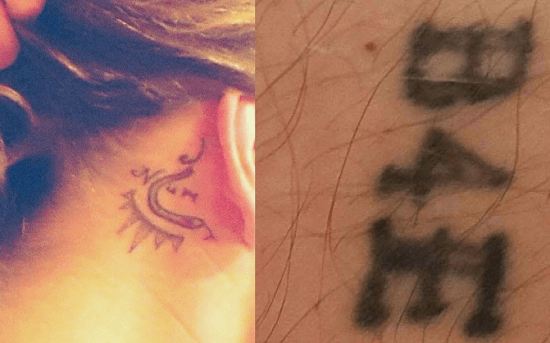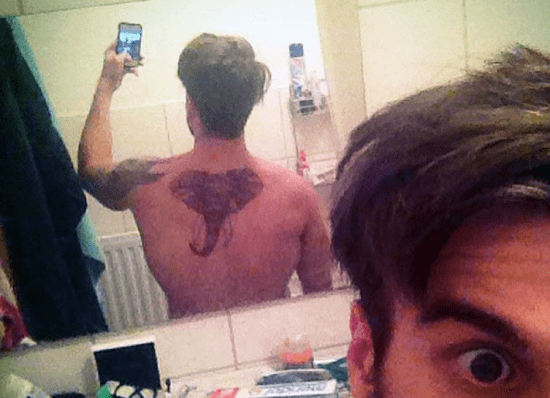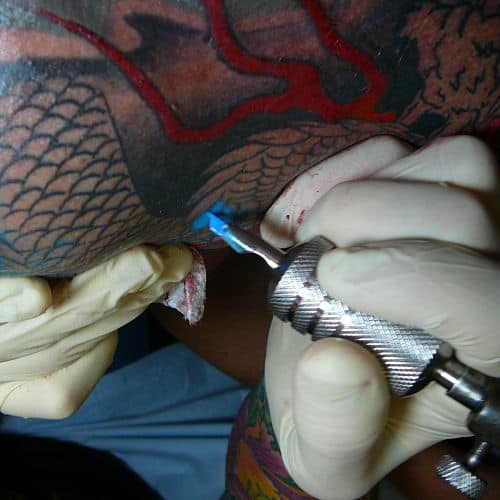Thus far in this thread we have discussed images as powerful communicative links between individuals and society around it. In this post, I want to focus on how images can help navigate the relationship with the self and how we can begin to understand how people inhabit images. I return, in a way, to a point that was made in the first post of this thread, namely that images produce different data, carry different messages, than words by themselves. I argue here that images offer us a mode of experience that is distinct from what we can put into words rather than just illustrative of it. To show this, I will make use of fieldwork conducted in a tattoo shop in Edinburgh in 2014. The fieldwork, which was carried out several days a week over two months, consisted of me ‘hanging out’ in the tattoo shop; chatting with both the artists and the clients as the pictures were inked into human skin; post tattoo and follow up coffees with clients and, yes, getting (and altering) a tattoo of my own.
Existing literature on tattoos has focussed largely on tattoos as a communication device or as branding the self as a member of a particular group (see for example Kang & Jones, 2007). While I do not disagree with this, I believe it is important to also understand tattoos as a praxis of inhabiting images and navigating the experience of the imagined self. My research found that the people I interviewed use the images on their body to come to terms with the multiplicity and ever changing nature of existence.
Images can express something that words cannot: being, feeling or thinking different, sometimes contradictory things at once.
I want to illustrate this with the help of a particular phenomenon I observed – and that many who have a tattoo will be familiar with – which happened around people getting their first tattoo:
Once you got your first one, you just want to get more and more.
…Ruby said, gently stroking the cling film over her wrist. She had just gotten an existing tattoo altered at the shop where I did my fieldwork. Minutes before I had watched the tattoo artist fill in the picture of a ship on her wrist in ever so subtle shades of red.
This was actually the first tattoo I got… It took me years to finally do it. I was so scared.
Scared of what? I ask. The pain?
I guess so. I was scared of the pain. But that would not have stopped me… what is a little pain compared with a lifetime of having this tattoo, ya know. No, I was scared because I thought that’s it. It’s permanent, what if I don’t like it and I have to live with it forever? But the moment I got it, all that changed. It was so satisfying. I had never felt this much in control before.
This change in perspective from pre-tattoo to post-tattoo is typical. Speaking both to first time tattooees about their fears and to tattoo veterans about their memories of making the decision to get their first tattoo, a clear shift became apparent. Before they got inked for the first time, the focus of concern about getting a tattoo was about its permanence. Jokingly, one man said I reckon if I don’t like it I can just get it removed. – only to earn himself a sceptical look from the tattoo artist who, joking himself, stopped in his tracks:
What, are we doing this or not? It’s in or out now.
No mate, I’m sure this is what I want.
Most of the people I spoke to had spent several years agonising over the decision whether to get a tattoo or not.
‘My body will never be like it was before again’ ‘what if I don’t like it in a few years and then I am stuck with it’ ‘I can barely commit to my girlfriend, how can I commit to a tattoo?’
Those were some of the worries troubling people in anticipation of their first tattoo.
However, things changed once the image had actually become part of the body. While tattoo veterans often spoke of a continued need to add to their existing tattoos (‘Hey man, my body is a living work of art, I have to feed it pictures so it can keep growing’) recent tattoo initiates who I met up with a few weeks after their first tattoo very often reported that their anxieties about the tattoos permanence had disappeared and that they were already thinking about the next tattoo.
So what changed?
I believe what has changed can be best explained with a third observation I made: tattoos, even though they are imagined as a permanent mark by the uninitiated, are inherently flexible. I asked Ruby why she had decided to have her wrist tattoo of a ship coloured in after all these years (she had gotten her first tattoo 7 years ago.)
It’s because of my father’s death, she replied. He was actually a sailor… well, he was in the marines. And because this tattoo is special for me anyway, being my first and it being a ship, I thought colouring it in would be a good way to remember him.
And why red? I ask.
I don’t know… red just felt right. To me it stands for love, for life… he was a very passionate person. But most importantly, he is the one who picked the name Ruby for me. It’s about our relationship, about him being a part of me that I will never lose.
The subject of how people mourn their loved ones through their skin deserves its own post. The point I want to draw attention to for now is the flexibility of Ruby’s ship tattoo which stands in stark contrast to the permanence that many are worried about before getting a tattoo. While initially the tattoo was, as she explained, about her travels and lust for adventure, she transformed it into something else – a meaningful memory of a loved one who had passed away but whose relationship with her lingered in the pigments of her skin.
This flexibility was evident even in cases where the tattoo was not actually physically changed:
I guess the snake [in my tattoo] means different things in different situations. Sometimes I tell people it’s because my Chinese Star sign is the Snake. Sometimes I tell them it’s about conquering fear because I have a snake phobia. And then there are some people who I tell about the spiritual part of it but that is rare… So which one is ‘true’? I guess all of them… It’s about how I chose to see it at any given point. Which doesn’t necessarily always translate into telling people how I feel about it. It’s an extremely personal thing.
Not all the responses I got were this reflexive. However, flexibility in how the meaning of a tattoo might change over time or from situation to situation, depending on how the person was feeling or who they were speaking to was an extremely frequent theme.

Before we look at what we can take away from this argument it is important to note that this study does not negate claims of tattoos as communication or externalised identity. Rather, in the spirit of multiplicity I explored, I seek to add another dimension of readings to tattoos. Further, my study is of course specific to its context, which might explain why regret (as can be observed in one of my favourite guilty pleasures, The Tattoo Fixers, on Channel four) featured so little in people’s relation to their tattoos. The artists at the tattoo shop I worked with operated with a code of ethics which would have stopped them from doing tattoos that may be too visible on first time tattooees or carrying out assignments that seemed to be poorly thought through by the client. Furthermore, there was usually at least several weeks between the initial meeting and the appointment. Thus, the people I spoke to were a somewhat self-selected group of people who had positive and quite reflexive relationships to tattoos. The study might have produced different results at, say, a 24 hour tattoo shop in Ibiza.
Nonetheless, the data still shows us what pictures inscribed on skin can do. But why, if they are so inherently flexible, get a tattoo at all? The people in my study got tattoos for all kinds of reasons but all the individuals I spoke to did it primarily for themselves rather than to communicate with others. While their interpretation of the tattoos was flexible it was nonetheless something to hold on to; a tool through which they were able to flexibly explore and most importantly assert agency over their self image.

This presents us with a core paradox of the visual: While a picture is at once an attempt to ‘capture’ something, to pin something down it simultaneously opens up ways to explore new multiplicities through varying interpretations. Images may be of the world but they also open up multiple and paradoxical ways to live in it. It is this paradox which is at once so powerful and so difficult to master that we must explore when we think visually. How can we do that? The posts in this thread have provided some examples: images provide unique data, they help us understand the nation, they can help us think about the invisible and they can weave together societies. My own doctoral research explores how indigenous people inhabit the publicly constructed image of indigeneity. What I have found so far, similar to my argument above, indicates that this happens in a multitude of sometimes contradictory ways. But I have learned that that is okay.
Images do not need to make the same kind of sense language does. Images are not clearly defined symbols. They exist not as language but in flexible relation with language. They are a mode of experience that invites us to explore our research subjects otherwise not possible.
References:
Kang, M. &. J. K., 2007. Why do people get tattoos?. Contexts, 6(1), pp. 42-47.





